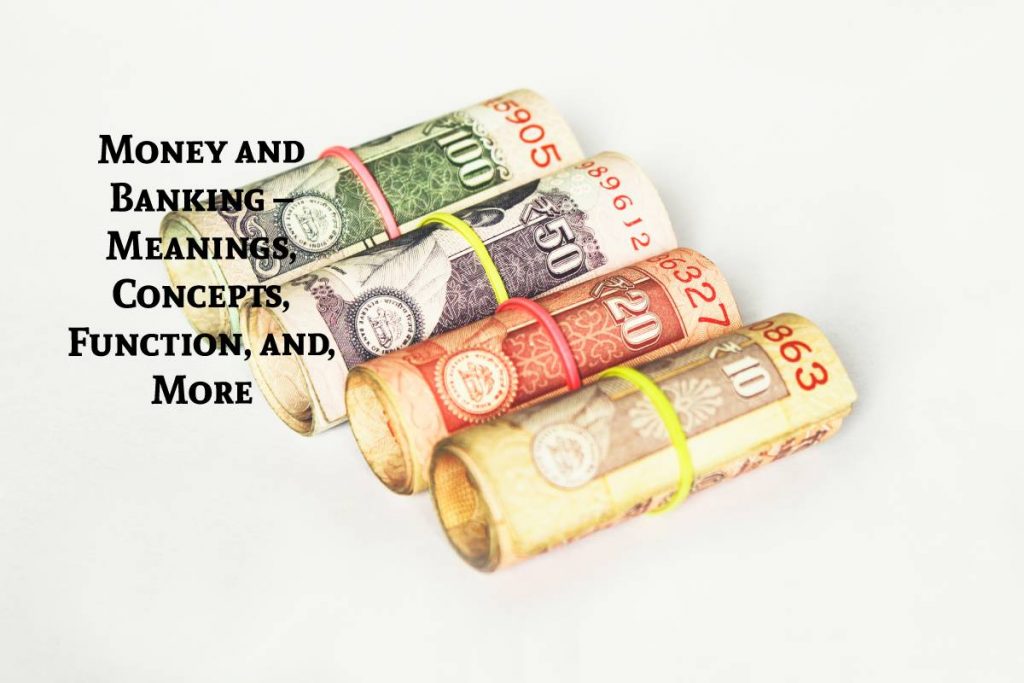Table of Contents
Meaning
Money and banking define as money deposited by people in banks in different banking products, mainly deposits. They were widely exchanged with each other and accepted as a means of payment. Even in regions far from their origin. Therefore, stop referring to specific amounts of metal and go directly to denominate the content coins guaranteed.
Money and Banking Concept
As a concept, money was born several thousand years back. When the cultivation of the land and the consequent specialization made trade and credit needs grow. Different homogeneous species of everyday use. And general acceptance (cattle, grains, salt) constitute the primitive means of payment and “units of account”. “Money” is called the “unit of account” or common denominator of the value of
goods, services, credits, and obligations.
Even though few metals are uses, a phenomenal diversity (the fruit, in turn, of dispersion. And relative isolation of ancient cultures) prevail in matters of names and units or weight measures using to divide them. However, from such diversity of units of measurement came up the words of many “units of account” .
Money and Banking Functions
The primary function of the money and banks is to manage money flow. Within the economy. Ensure that the money in deposits is use for all types of loans. Credit, and financing, along the same lines, their main objective is to facilitate access to savings and funding .For individuals and corporations as well as to provide them with technical assistance and training. “Credit” is understood as the mutual agreement between parties .By which one of them (the borrower) receives on loan (from the lender) a certain amount. In return for what is receiving the borrower issues. In favor of the lender, a fiduciary instrument or credit for which he undertakes to repay it within a period and with an establishing remuneration.
Development of Banking
Development Banking over the years has been one of the primary vehicles of the Mexican State to promote economic growth and social welfare. Supporting with financing the creation and expansion of productive companies, with particular emphasis on priority areas for development.
The words “credit” and “trust” refer precisely to the “belief” or “faith” or “trust” in the fulfilment of the mutual any species can be the object of a loan. The credit does not pre- suppose the existence of money. Now, since there are “monetary species,” it is to be hope that most of the credit operations are perfect or material, taking them for grant object. Both to buy things and to pay off obligations, and borrowers prefer to receive from lenders acceptable specie as means of payment. Which will be correspondingly using the name and implement the respective fiduciary duties. In addition to the functions of managing savings and allocating credit efficiently. There is a third equally important function that consists of facilitating the settlement of obligations that occur between economic agents, that is, banks play a strategic role.
Money and Banking Important
Money held in demand deposits allows banks to make loans using their customers’ deposits, thereby increasing the amount of money in the economy. In addition, bank money will enable banks to create more money because people who have checking accounts do not withdraw their deposits simultaneously. As a result, banks are forcing to keep only a fraction of total deposits as a ratio. Moreover, because this behavior is the same for all customers. Banks can estimate how much is the minimum capital that they can always dispose of.
Bank money legal reserve ratio
The Central Bank determines said percentage. In other words, the proportion of public deposits that financial institutions have to keep in the form of liquid assets (cash in hand). Bank Money Creation Example Part of the amount of these loans returns. The financial institutions in the form of new bank deposits. For example, the company that has receive the credit of 4,500 euros uses it to buy a car. The seller gets the money from this sale and deposits it in his account.
The monopoly of currency issuance allows the Central Banks limit money in the hands of the public. The function is complementing by the restriction of monetary certificates and credit to the public. To moderate prices in the market. Whenever , the policy orthodoxy monetary policy dominant in the world environment in recent decades. Assuming the bank Central responsibility to limit the amount of money to the public to control aggregate demand and its impact on market prices.
Conclusion
Money and banking, the book deals with the open economy’s monetary .Economics and financial markets, with a current focus and case studies on emerging economies.
